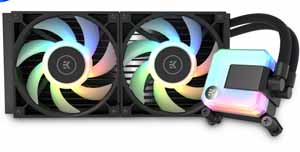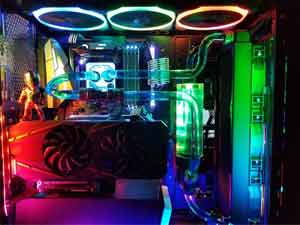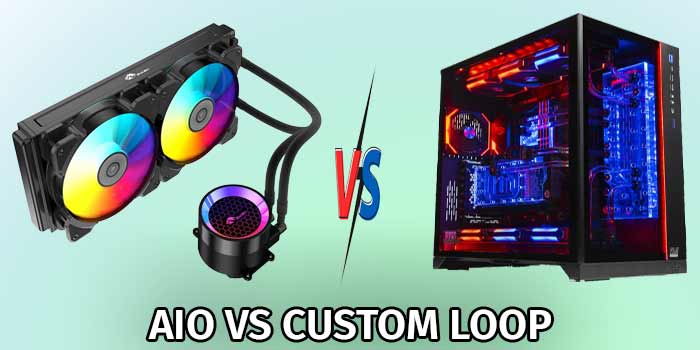Water cooling systems have always been helpful to pro gamers during their gameplays. But, with the two equally well-functioning options to choose from, it’s safe to say that even these experts have had trouble deciding between an AIO vs Custom Loop WCS.
This is an even more confusing dilemma if you’re new to the gaming world. Both systems have pros and cons, but it can get overwhelming to weigh them out and settle on one.
In the following article, we’ll be unpacking all the key differences between the two liquid cooling solutions and sketch out a clear picture for both to make it easier for you to come to a decision.
Here’s what we’ve gathered.
About of AIO (All-in-One)

Just like its name suggests, an AIO liquid CPU cooler has all you need to keep the temperature of your PC’s processors as low as possible. Most users go for an AIO WCS because of its low maintenance requirements. Some of the prominent features of this system include –
Assembly and Build
Out of the box, an AIO cooler comes with a water block, a set of tubes, a pump, and a radiator. These are some of the only parts you will have to assemble yourself, while everything else in the system is already set up for you. Altogether, the installation process for an AIO takes no more than 20 minutes.
The average AIO WCS carries a simple build with limited designs and patterns.
Maintenance

Since almost everything is pre-assembled from their manufacturers, most AIO coolers have little to no maintenance requirements. All the vital parts come tightly sealed, so there are very low chances of leaks. Plus, it does not require frequent refilling as other WCS solutions do.
Performance

AIO coolers do a great job when cooling central processors. They are able to dissipate the heat produced from the CPU and reduce the chances of overheating. However, AIOs have also gained criticism for not cooling other regions past the central processor because of their size and cost effective build.
Advantages and Disadvantages of AIO
This will be a deciding factor to make you understand whether or not you should opt for this option.
Pros
- No leaks, everything is pre-assembled and tightly sealed by manufacturers
- Easy to install, whole process takes less than half an hour with simple parts
- Low maintenance, does not require frequent water refills or cleaning
- Cools central processors thoroughly and reduces chances of overheating
- Compact and simple build, good for beginners and minimalists
- Cost efficient, all vital components are included without the need for purchasing extra parts
Cons
- Does not cool other components past the central processor effectively
- Makes more noise than air coolers
About of Custom Loop

On the other hand, custom loops are also great WCS options. They are known for their detailed and often flashy exteriors with intricate tubes, reservoirs, and water blocks, and more. The key characteristics are –
Assembly and Build
Installing a custom loop is a painstaking task. Unlike with an AIO, every part has to be assembled manually. You would have to go step by step to gather the parts, clean the cooling parts, attach all water blocks, install the components and tubes, modify cables, add liquid, and more.
Depending on how intricate your customized loop is, it can take anywhere from an hour to almost 6 hours of extensive work.
However, you will end with a much more comprehensively structured cooler that will definitely add to your room’s decor.
Maintenance

When it comes to a custom loop, maintenance is sort of a gray area. While most WCSs require cleaning and/or refills every 6 months or so, a custom loop might need more frequent cleaning depending on how complex its build is.
Regardless, a custom loop is still a sealed unit, so it should not require much maintenance.
Performance

The best factor about a custom loop is that every single aspect of it can be personalized according to your PC’s requirements. AIOs mostly work on the processor, but a custom loop can go beyond that and cool RAM, CPU, and even power supply providing a much wider cooling coverage.
You can add or take away as many components from your custom loop as you desire to make it adjust to your PC for the best possible performance.
Advantages and Disadvantages of Custom Loop

Let’s see if this option is better than AIO or not.
Pros
- Fully customizable, user can add or remove as many components as needed
- Adjusts to any type of PC, can be personalized to suit every PC’s requirements
- High visual appeal, user can choose to add as many LEDs/patterns as they want
- Wide cooling coverage, cools the central processor, RAM, CPU, power supply, etc.
- Requires less frequent maintenance, depending on the complexity of the build
- Excellent performance, adjustable for consistent and interrupted cooling
Cons
- Very expensive
- Has higher chances of leaks than AIO because of self-assembled parts
Conclusion
To end the AIO vs custom loop dilemma, which one should you buy after all? Our suggestion is that you go for an AIO if you’re new to WCSs, and want something simple yet reliable. AIOs are also great for minimalists on a budget that don’t mind limited performance.
However, if you want a high performing cooler, a custom loop is the best way to go. We think experienced PC gamers will benefit from it more and enjoy assembling the components according to their choice. It’s also an ideal option if you want a cooler that is fully adjustable.
Accessories: Top 7 Pick Of DDR2 Ram

